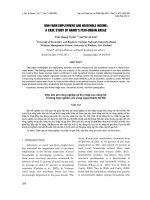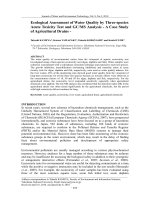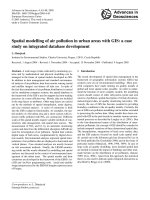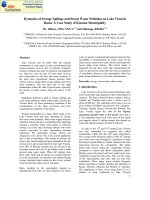Effect of urbanization on natural groundwater recharge within Hanoi city - a case study of Long Bien district
Bạn đang xem bản rút gọn của tài liệu. Xem và tải ngay bản đầy đủ của tài liệu tại đây (873.99 KB, 5 trang )
������������������������������������������������������������������������������������������������������������������������������������������������������������������������������������������������������������������������������������������������������������������������������������������������������������������������������������������������������������������������������������������������������������������������������������������������������������������������������������������������������������������������������������������������������������������������������������������������������������������������������������������������������������������������������������������������������������������������������������������������������������������������������������������������������������������������������������������������������������������������������������������������������������������������������������������������������������������������������������������������������������������������������������������������������������������������������������������������������������������������������������������������������������������������������������������������������������������������������������������������������������������������������������������������������������������������������������������������������������������������������������������������������������������������������������������������������������������������������������������������������������������������������������������������������������������������������������������������������������������������������������������������������������������������������������������������������������������������������������������������������������������������������������������������������������������������������������������������������������������������������������������������������������������������������������������������������������������������������������������������������������������������������������������������������������������������������������������������������������������������������������������������������������������������������������������������������������������������������������������������������������������������������������������������������������������������������������������������������������������������������������������������������������������������������������������������������������������������������������������������������������������������������������������������������������������������������������������������������������������������������������������������������������������������������������������������������������������������������������������������������������������������������������������������������������������������������������������������������������������������������������������������������������������������������������������������������������������������������������������������������������������������������������������������������������������������������������������������������������������������������������������������������������������������������������������������������������������������������������������������������������������������������������������������������������������������������������������������������������������������������������������������������������������������������������������������������������������������������������������������������������������������������������������������������������������������������������������������������������������������������������������������������������������������������������������������������������������������������������������������������������������������������������������������������������������������������������������������������������������������������������������������������������������������������������������������������������������������������������������������������������������������������������������������������������������������������������������������������������������������������������������������������������������������������������������������������������������������������������������������������������������������������������������������������������������������������������������������������������������������������������������������������������������������������������������������������������������������������������������������������������������������������������������������������������������������������������������������������������������������������������������������������������������������������������������������������������������������������������������������������������������������������������������������������������������������������������������������������������������������������������������������������������������������������������������������������������������������������������������������������������������������������������������������������������������������������������������������������������������������������������������������������������������������������������������������������������������������������������������������������������������������������������������������������������������������������������������������������������������������������������������������������������������������������������������������������������������������������������������������������������������������������������������������������������������������������������������������������������������������������������������������������������������������������������������������������������������������������������������������������������������������������������������������������������������������������������������������������������������������������������������������������������������������������������������������������������������������������������������������������������������������������������������������������������������������������������������������������������������������������������������������������������������������������������������������������������������������������������������������������������������������������������������������������������������������������������������������������������������������������������������������������������������������������������������������������������������������������������������������������������������������������������������������������������������������������������������������������������������������������������������������������������������������������������������������������������������������������������������������������������������������������������������������������������������������������������������������������������������������������������������������������������������������������������������������������������������������������������������������������������������������������������������������������������������������������������������������������������������������������������������������������������������������������������������������������������������������������������������������������������������������������������������������������������������������������������������������������������������������������������������������������������������������������������������������������������������������������������������������������������������������������������������������������������������������������������������������������������������������������������������������������������������������������������������������������������������������������������������������������������������������������������������������������������������������������������������������������������������������������������������������������������������������������������������������������������������������������������������������������������������������������������������������������������������������������������������������������������������������������������������������������������������������������������������������������������������������������������������������������������������������������������������������������������������������������������������������������������������������������������������������������������������������������������������������������������������������������������������������������������������������������������������������������������������������������������������������������������������������������������������������������������������������������������������������������������������������������������������������������������������������������������������������������������������������������������������������������������������������������������������������������������������������������������������������������������������������������������������������������������������������������������������������������������������������������������������������������������������������������������������������������������������������������������������������������������������������������������������������������������������������������������������������������������������������������������������������������������������������������������������������������������������������������������������������������������������������������������������������������������������������������������������������������������������������������������������������������������������������������������������������������������������������������������������������������������������������������������������������������������������������������������������������������������������������������������������������������������������������������������������������������������������������������������������������������������������������������������������������������������������������������������������������������������������������������������������������������������������������������������������������������������������������������������������������������������������������������������������������������������������������������������������������������������������������������������������������������������������������������������������������������������������������������������������������������������������������������������������������������������������������������������������������������������������������������������������������������������������������������������������������������������������������������������������������������������������������������������������������������������������������������������������������������������������������������������������������������������������������������������������������������������������������������������������������������������������������������������������������������������������������������������������������������������������������������������������������������������������������������������������������������������������������������������������������������������������������������������������������������������������������������������������������������������������������������������������������������������������������������������������������������������������������������������������������������������������������������������������������������������������������������������������������������������������������������������������������������������������������������������������������������������������������������������������������������������������������������������������������������������������������������������������������������������������������������������������������������������������������������������������������������������������������������������������������������������������������������������������������������������������������������������������������������������������������������������������������������������������������������������������������������������������������������������������������������������������������������������������������������������������������������������������������������������������������������������������������������������������������������������������������������������������������������������������������������������������������������������������������������������������������������������������������������������������������������������������������������������������������������������������������������������������������������������������������������������������������������������������������������������������������������������������������e 3
U1
28
34
56
81
U2
16
22
25
19
Green
56
44
19
0
Table 2. Parameters affected due to changes of HRUs properties
Parameters
Base state
State 1
State 2
State 3
Average plant cover density
0.23
0.21
0.16
0.12
Average surface depression depth
available for water storage, m
0.069
0.062
0.043
0.026
Total pervious area, %
74.3
56.5
44.4
33.7
JOURNAL OF SCIENCE AND TECHNOLOGY IN CIVIL ENGINEERING
Vol. 11 No. 6
11 - 2017
207
RESEARCH RESULTS AND APPLICATIONS
monthly average flux components of precipitation including
groundwater recharge are presented on the Fig. 3.
3.2 Groundwater heads
Simulated groundwater heads of the top unconfined aquifer within the area vary in range +10 to -3 m
(see Fig. 4). The minimum water table elevation is in
the central part of the Long Bien district where the cone
of depression is formed due to extensive groundwater
pumping. As shown in Fig. 5, the depression reaches its
maximum in April each year when it gets to the point -3 m
below Mean Sea Level (MSL), which is 13 meters below
the land surface. In October of the each simulated year,
the groundwater table reaches its maximum elevation.
Figure 3. Simulated water balance components
Figure 4. Simulated groundwater heads within the top unconfined aquifer (Holocene aquifer) for two dates:
A) 01 April 2001; B) 01 October 2001
The presented results of the simulations allow
to conclude about several important characteristics of
the studied aquifer: (1) the effect of the municipal water
pumping wells located in the central part of the area is
significant; (2) the direction of water exchange between
the aquifer and Red and Duong rivers changes during the
year: water from the river discharges to the aquifer most
part of the year, but flow in opposite direction occurs after the rain season for the period from September to November; (3) groundwater table heads rise up to the land
surface in local depression areas during rainy seasons,
which means that groundwater can be discharged to the
surface water bodies as well as to the urban sewage system and open drainage channels. The last two phenomena tell about the importance of the surface recharge for
the local groundwater system dynamics.
Figure 5. Profiles of the simulated groundwater
heads within the top unconfined aquifer (Holocene
aquifer) and land surface elevation for two dates:
Top-01 October 2001, Bottom-01 April 2001.
Position of the profiles show on the Figure 4
3.3 Application of the land cover change scenarios
Application of the land cover changes caused by urbanization scenarios showed that the relative decrease of
the groundwater recharge can be significant: its estimated
values reduced from 77mm per year for the base condition
to 71, 58, and 42mm per year after applying three area
development scenarios, which are in relative values 92%,
75% and 54% respectively. The recharge reduction however is negligibly small in overall groundwater balance. The
groundwater abstraction within the area is mainly compensated by the boundary inflow from Red and Duong rivers-to
76% and to 24% from the surface recharge (Fig. 6).
208
Vol. 11 No. 6
11 - 2017
Figure 6. Simulated GW recharge values (mm)
for different stages of imitated area developemen
JOURNAL OF SCIENCE AND TECHNOLOGY IN CIVIL ENGINEERING
RESEARCH RESULTS AND APPLICATIONS
Changes of the land cover properties due to urban development in the area can decrease the groundwater recharge from the surface significantly. However, these changes are not considerable for groundwater
balance since the portion of the recharge in total water inflow to the aquifer is relatively small and the deficit
is covered by the boundary inflow. The expected land cover and land use changes are not critical for the
groundwater balance in Long Bien.
4. Conclusion
This study has investigated the role of various land surface characteristics on the groundwater recharge within area of the Long Bien district of the city of Hanoi by applying the coupled surface-groundwater
numerical model and considering the effect of land cover changes caused by urban development of the area
on groundwater balance. The most important results can be summarized as the following:
- The groundwater recharge from the land surface to the adjacent Holocene aquifer is relatively small
as compared to precipitation-only about 5% or 77mm.
- The groundwater abstraction within the area is mainly compensated by the boundary inflow from the
Red and Duong rivers-to 76% and to 24% from the surface recharge.
- Groundwater table elevation reaches the surface at the depression areas at the end and after the rainy
season, which means that the water stored in lakes and ponds does not contribute to groundwater recharge
during this period and is lost for evaporation. This fact should be considered in planning the artificial recharge.
- Changes of the land cover properties due to urban development in the area can decrease the
groundwater recharge from the surface significantly, however these changes are not considerable for
groundwater balance since the portion of the recharge in total water inflow to the aquifer is relatively small
and the deficit is covered by the other sources.
The results of the study should not be considered as the exact estimations of the groundwater balance components and should be validated either by field measuremental data or by applying more sophisticated model. However, they can be used as good initial approximations for the further investigations and
should be considered in decision-making activities in the field of water resources management.
Acknowledgement
The study was conducted under the Nafosted research project (DT. NCCB-DDHUD. 2012-G/02).
References
1. Duc L.V. (2012), Sanitation of Water Source and Treatment of Garbage and Wastes in Hanoi, Statement
at the East Asian and Middle-South American Conference on Environmental Industry.
2. Nguyen T.Q., Helm D.C. (1996), “Land Subsidence due to Groundwater Withdrawal in Hanoi, Vietnam”,
International Journal of Rock Mechanics and Mining Science and Geomechanics, 33(7):72-84.
3. Dan N.V. (2002), “Overall Management of Underground Water Resource in Hanoi Area for Satisfying
Water-consumed Demand of the of the City”, Procedding of International Conference on Sustainable Architectural Design and Urban Planning, 52.
4. Trinh M.T., Delwyn G.F. (2000), “Modeling subsidence in the Hanoi City Area, Vietnam”, Canadian Geotechnical Journal, 34.
JOURNAL OF SCIENCE AND TECHNOLOGY IN CIVIL ENGINEERING
Vol. 11 No. 6
11 - 2017
209









